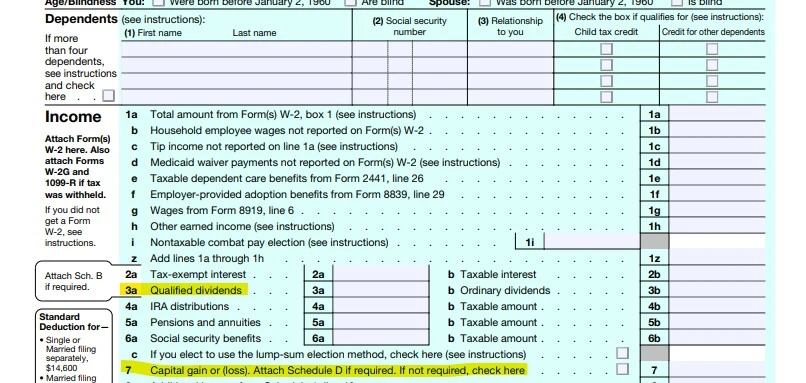Qualified Dividends and Capital Gain Tax Worksheet Explained
The Qualified Dividends and Capital Gain Tax Worksheet is a powerful tool designed to help you determine your tax liability on investment income. You can find it in the IRS Instructions for Form 1040 (and 1040-SR) and in many tax filing and preparation software services, or a tax pro can handle it for you.
Let’s break down what this worksheet is, how it works, and why it matters—especially for investors concerned with federal taxes, such as those looking into capital gains tax Florida.
What Is the Qualified Dividends and Capital Gain Tax Worksheet?
The worksheet is an IRS-provided guide used during tax preparation. Its primary purpose is to help you:
- Calculate Tax on Qualified Dividends: These dividends come from U.S. companies or eligible foreign corporations and are taxed at preferential rates (0%, 15%, or 20%) rather than at your ordinary income tax rate.
- Determine Tax on Long-Term Capital Gains: Profits from the sale of assets held for more than one year benefit from lower tax rates, similar to qualified dividends. Short-term gains, in contrast, are taxed at your regular income rate.

Above is a snapshot of IRS Form 1040 showing where qualified dividends and capital gains are reported. Here, Line 3a of Form 1040 is for qualified dividends (usually reported from Box 1b on Form 1099-DIV), and Line 7 is for capital gains or losses, often requiring Schedule D.
After entering these amounts, you can use the tax computation worksheet to find the correct tax rates. If you have collectibles or specific small-business stock, the 28 rate gain worksheet may apply. For past-years reference, the qualified dividends and capital gain tax worksheet 2023 is a useful example of how these calculations might look in practice.
How the Tax Computation Worksheet Works
The tax computation worksheet simplifies the process of calculating your tax liability by guiding you through several key steps:
- Identifying Income Sources:
- Confirm that your dividends meet the IRS criteria for qualification.
- Determine whether your capital gains are long-term or short-term.
- Applying the Correct Tax Rates:
- For qualified dividends and long-term capital gains, the worksheet helps apply the lower tax rates.
- Since the IRS taxes short-term gains at ordinary income rates, compute them separately.
- Incorporating Additional Factors:
- The worksheet includes provisions for the Net Investment Income Tax (NIIT) of 3.8% if your income exceeds specific thresholds.
- It also factors in current income thresholds and limits, ensuring an accurate tax computation.
Overview of the 28 Rate Gain Worksheet
We use The 28 rate gain worksheet for calculating taxes on certain types of gains—like collectibles or specific small business stock—that are taxed at a 28% rate. While it’s separate from the main worksheet for qualified dividends and long-term capital gains, understanding its purpose helps in comprehensive tax planning.
Understanding the Basics of Qualified Dividends and Capital Gains
Learning about qualified dividends and capital gains can help lower your taxes. We’ll cover three key points about these financial tools.
Qualified Dividends?
Qualified dividends come from U.S. or certain foreign companies under certain rules. You must hold the stock for more than 60 days before the dividend date. For preferred stock, it’s over 90 days. The tax on these dividends ranges from 0% to 20%. It depends on how much money you make.
Capital gains?
Capital gains are profits from selling assets like stocks or real estate. The tax rate depends on how long you held the asset. Long-term gains, held over a year, have lower rates of 0%, 15%, or 20%.
If you sell an investment within a year, the IRS taxes your gains at your regular income tax rate, which can reach up to 37%. Additionally, if your income exceeds certain thresholds, the IRS may impose a 3.8% Medicare tax.
Conclusion
The Qualified Dividends and Capital Gains worksheet can feel confusing, especially when combined with Form 1040. Mistakes on these forms can mean paying more taxes or facing IRS questions. At JC Castle Accounting, we make things simple. Our friendly advisors will show you exactly how to fill out these worksheets correctly.
Contact us today for a quick consultation. We’ll handle the tricky parts so you can relax at tax time!
FAQ
What are qualified dividends?
Qualified dividends come from U.S. or certain foreign corporations. They must meet specific conditions, like holding periods. These dividends are taxed at lower rates, ranging from 0% to 20%, based on your income.
What is the difference between ordinary and qualified dividends?
The IRS taxes ordinary dividends as regular income. In contrast, the IRS applies lower capital gains rates to qualified dividends when they meet its criteria.
How do I calculate the tax on my qualified dividends and capital gains?
Use the Qualified Dividends and Capital Gain Tax Worksheet. It helps calculate taxes on qualified dividends and long-term gains. The worksheet uses preferential rates and thresholds for accurate calculations.
Why are the tax rates on qualified dividends lower than on ordinary dividends?
Lower tax rates on qualified dividends encourage long-term investment. They provide tax benefits for holding shares in certain corporations. This promotes economic growth and stability.
Can I use tax software to automatically calculate taxes on qualified dividends and capital gains?
Yes, tax software can automatically calculate taxes on qualified dividends and capital gains. It uses the latest worksheets and tax laws for accurate filing.
What are the thresholds for the 0%, 15%, and 20% tax rates on qualified dividends for 2024?
The 2024 tax rates for qualified dividends depend on your filing status and income. Check the IRS guidelines or latest tax rate tables for exact information.
How can I lower taxes on capital gains?
You can lower your capital gains taxes by holding investments longer (over a year) to qualify for lower long-term rates, offsetting gains with losses, or using tax-advantaged accounts. For more helpful tips, check out our guide on Capital Gain Tax 2023.

